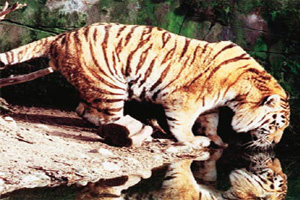The conservation of species refers to the sustainable use and regulation of the existent species, allowing their indefinite continuity in the space they inhabit. This is a concept that must be passed on from generation to generation and has both an ethical and natural base.
The human being, as a rational being, must acquire the responsibility of taking on immediate actions and in the long-term that benefit the conservation of the existent flora and fauna, because the deterioration of both alters natural relationships generated among species, influencing, at the same time, human beings themselves.
Due to this, diverse evaluation initiatives have been undertaken, which allow the implementation of better conservation and protection plans for species. There is no longer ignorance regarding the situation each known organism is in, being the duty of governments, organizations and also each of us to face this important problem that affects our surroundings and our «neighbors», animals and plants.
Green action
In 1948, under the name of «International Union for The Conservation of Nature and Natural Resources«, one of the main non-profit organizations concerned about the conservation of the environment and the correct use of non-renewable resources is born.
Currently known under the name «IUCN, World Conservation Union«, it not only encourages the preservation of nature, but also the sustained development of all human beings. It is an internationally natured organism that manages to group other institutions, whose focus is promoting agreements, create legislation related to the subject, develop strategies and perform studies that ease the care and adequate use of natural resources.
The IUCN puts together what is considered the most complete inventory regarding the state of conservation of species worldwide. It is the so-called Red List, which through a series of scientific criteria, catalogues and evaluates the risk of extinction of the different animal and plant species that inhabit our planet. Every four years, a thorough revision is done of every species included in the Red List. Up until now they are been performed in 1996, 2000 and 2004. A new general evaluation is expected for next year; however, during 2006 and 2007, updates were conducted regarding the real state of conservation of the species.
It was put together for the first time in 1963, but over time it has been modified to make it more complete each time. The evaluation criteria were changed and new variables were included, making the study more and more rigorous. All of the know birds were only evaluated in 1988, and the same took place in 1996 with all the existent mammals. During the year 2000, a list was compiled that included both animals and plants, including certain parameters that eased their understanding at local levels.
This way, this organization seeks to raise awareness regarding the state of conservation (many times concerning) of the species in natural conditions, not only to safeguard diversity, but also to encourage the government s of different countries to implement their respective conservation policies.
Conservation categories
There are diverse classifications in order to determine the conservation conditions a species is found in. One of the most used is the World Conservation Union’s (IUCN), which determined nine possible ranks of preservation. This way, according to this institution and the current environmental legislation, a species may be considered:
– Extinct (EX): when there is no doubt regarding the total disappearance of individuals of a studied species. This, because absolute death has been confirmed after a search in the places where the studied species was normally found, at the right times and according to the vital cycles and conditions.
– Extinct in the Wild (EW): a species qualifies within this category when, after several studies, no individual has been detected in the wild. But, some specimens or populations are kept artificially or in geographical areas that are not common to the species.
– Critically Endangered (CR): this category considers species that, after several studies, it has been concluded that they are facing an extremely high risk of extinction in the wild.
– Endangered (EN): it includes species that present a very high risk of extinction.
– Vulnerable (VU): although it cannot be considered endangered, it is on the verge of qualifying for this category.
– Near Threatened (NT): another borderline rank, whose species are on the verge of reaching a higher risk of extinction. The ones that qualify for this rank will be part of the more vulnerable and critical categories in a «near future»
– Least Concern (LC): that do no present a major risk of extinction because there are abundant populations and they are widely distributed in their natural habitats.
– Insufficient Data (DD): it includes all of the species that, even though studied, do not present considerable data regarding the size and distribution of their population, reason for which they cannot be included in any of the aforementioned ranks. In other words, their vulnerability is unknown.
– Not Evaluated (EN): species that has not been registered in any of the aforementioned qualifications.








 En 1973 muere Pablo Neruda
En 1973 muere Pablo Neruda